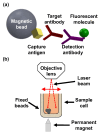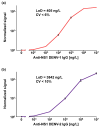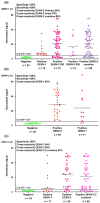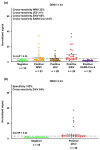Sensitivity and Cross-Reactivity Analysis of Serotype-Specific Anti-NS1 Serological Assays for Dengue Virus Using Optical Modulation Biosensing
- PMID: 40710103
- PMCID: PMC12293919
- DOI: 10.3390/bios15070453
Sensitivity and Cross-Reactivity Analysis of Serotype-Specific Anti-NS1 Serological Assays for Dengue Virus Using Optical Modulation Biosensing
Abstract
Dengue virus (DENV) poses a major global health concern, with over 6.5 million cases and 7300 deaths reported in 2023. Accurate serological assays are essential for tracking infection history, evaluating disease severity, and guiding vaccination strategies. However, existing assays are limited in their specificity, sensitivity, and cross-reactivity. Using optical modulation biosensing (OMB) technology and non-structural protein 1 (NS1) antigens from DENV-1-3, we developed highly sensitive and quantitative serotype-specific anti-DENV NS1 IgG serological assays. The OMB-based assays offered a wide dynamic range (~4-log), low detection limits (~400 ng/L), fast turnaround (1.5 h), and a simplified workflow. Using samples from endemic (Vietnam) and non-endemic (Israel) regions, we assessed intra-DENV and inter-Flavivirus cross-reactivity. Each assay detected DENV infection with a 100% sensitivity for the corresponding serotype and 64% to 90% for other serotypes. Cross-reactivity with Zika, Japanese encephalitis, and West Nile viruses ranged from 21% to 65%, reflecting NS1 antigen conservation. Our study provides valuable insights into the cross-reactivity of DENV NS1 antigens widely used in research and highlights the potential of OMB-based assays for quantitative and epidemiological studies. Ongoing efforts should aim to minimize cross-reactivity while maintaining sensitivity and explore integration with complementary platforms for improved diagnostic precision.
Keywords: Japanese encephalitis virus; West Nile virus; cross-reactivity; dengue virus; non-structural protein 1; optical detection; serology; zika virus.
Conflict of interest statement
The authors declare no conflicts of interest.
Figures






Similar articles
-
Multiplex sample-sparing assay for detecting type-specific antibodies to Zika and dengue viruses: an assay development and validation study.Lancet Microbe. 2025 Feb;6(2):100951. doi: 10.1016/j.lanmic.2024.07.014. Epub 2024 Dec 25. Lancet Microbe. 2025. PMID: 39730005
-
Dominance of DENV-1 and Flavivirus Serological Cross-Reactivity During the 2016 Dengue Outbreak in Vietnam.J Med Virol. 2025 Aug;97(8):e70569. doi: 10.1002/jmv.70569. J Med Virol. 2025. PMID: 40838976 Free PMC article.
-
Development of Envelope Protein Antigens To Serologically Differentiate Zika Virus Infection from Dengue Virus Infection.J Clin Microbiol. 2018 Feb 22;56(3):e01504-17. doi: 10.1128/JCM.01504-17. Print 2018 Mar. J Clin Microbiol. 2018. PMID: 29263206 Free PMC article.
-
Meta-Analysis of Dengue Severity during Infection by Different Dengue Virus Serotypes in Primary and Secondary Infections.PLoS One. 2016 May 23;11(5):e0154760. doi: 10.1371/journal.pone.0154760. eCollection 2016. PLoS One. 2016. PMID: 27213782 Free PMC article.
-
Antibody tests for identification of current and past infection with SARS-CoV-2.Cochrane Database Syst Rev. 2022 Nov 17;11(11):CD013652. doi: 10.1002/14651858.CD013652.pub2. Cochrane Database Syst Rev. 2022. PMID: 36394900 Free PMC article.
References
-
- WHO Dengue and Severe Dengue. World Helath Organization. [(accessed on 9 July 2025)]. Available online: https://www.who.int/news-room/fact-sheets/detail/dengue-and-severe-dengue.
-
- Jentes E.S., Lash R.R., Johansson M.A., Sharp T.M., Henry R., Brady O.J., Sotir M.J., Hay S.I., Margolis H.S., Brunette G.W. Evidence-based risk assessment and communication: A new global dengue-risk map for travellers and clinicians. J. Travel. Med. 2016;23:6. doi: 10.1093/jtm/taw062. - DOI - PMC - PubMed
MeSH terms
Substances
Grants and funding
LinkOut - more resources
Full Text Sources
Medical
Research Materials
Miscellaneous

